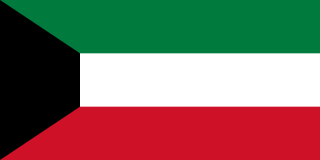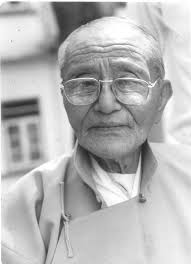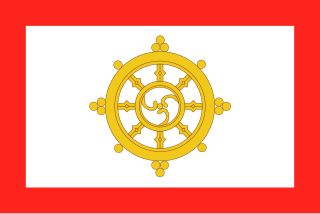State of India (1975–present)
The Government of Sikkim can be represented by a banner that depicts the emblem of the state on a white background. [3]

At present there is no official flag of Sikkim, a state in India. The independent Kingdom of Sikkim did have a national flag until it became a state of India in 1975.
The Kingdom of Sikkim had used several flags during its history. They all contained a Buddhist khorlo prayer wheel with the gankyil as the central element. [1]
Until 1967, the previous flag showed a very complex design with a fanciful border and religious pictograms surrounding the khorlo.
A more simple design was adopted in 1967 because of the difficulty in duplication of the complex flag. The border became solid red, the pictograms were removed and the wheel was redesigned.
With the admission of Sikkim to the Republic of India and with the abolition of the monarchy, the flag lost its official status in 1975. [2]
The Government of Sikkim can be represented by a banner that depicts the emblem of the state on a white background. [3]


Sikkim is a state in northeastern India. It borders the Tibet Autonomous Region of China in the north and northeast, Bhutan in the east, Koshi Province of Nepal in the west, and West Bengal in the south. Sikkim is also close to the Siliguri Corridor, which borders Bangladesh. Sikkim is the least populous and second smallest among the Indian states. Situated in the Eastern Himalaya, Sikkim is notable for its biodiversity, including alpine and subtropical climates, as well as being a host to Kangchenjunga, the highest peak in India and third highest on Earth. Sikkim's capital and largest city is Gangtok. Almost 35% of the state is covered by Khangchendzonga National Park – a UNESCO World Heritage Site.

The flag of Kuwait was adopted on September 7, 1961, and officially hoisted November 24, 1961. Before 1961, the flag of Kuwait was red and white, like those of other Persian Gulf states at the time, with the field being red and words or charges being written in white.

The Chogyal were the monarchs of the former Kingdom of Sikkim, which belonged to the Namgyal dynasty. The Chogyal was the absolute monarch of Sikkim from 1642 to 1973, and the constitutional monarch from 1973 to 1975, when the monarchy was abolished and the Sikkimese people voted in a referendum to make Sikkim the 22nd state of India.

The history of Sikkim begins with the indigenous Lepcha's contact with early Tibetan settlers. Historically, Sikkim was a sovereign Monarchical State in the eastern Himalayas. Later a protectorate of India followed by a merger with India and official recognition as a state of India. Lepchas were the main inhabitants as well as the Ruler of the land up to 1641. Lepchas are generally considered to be the first people, indigenous to Sikkim also includes Darjeeling.

Kazi Lhendup Dorjee, also spelled Lhendup Dorji or Lhendup Dorji Khangsarpa was an Indian politician who was the 1st chief minister of Sikkim from 1975 to 1979 after its union with India. He was the 1st Prime Minister of Sikkim from 1974 to 1975. He also served as the Executive Council of Sikkim from 1967 to 1970. He was a member of INC after 1975 and Sikkim National Congress before 1975.

The Kingdom of Sikkim, officially Dremoshong until the 1800s, was a hereditary monarchy in the Eastern Himalayas which existed from 1642 to 16 May 1975, then it was merged with the Republic of India. It was ruled by Chogyals of the Namgyal dynasty.

The Emblem of Sikkim is currently used as the official seal of the Government of Sikkim, India. It was earlier used as the coat of arms of the House of Namgyal and the Kingdom of Sikkim. The emblem is known as the Kham-sum-wangdu. It was designed in 1877 by Robert Taylor.

The Emblem of Tamil Nadu is the official state emblem of Tamil Nadu and is used as the official state symbol of the Government of Tamil Nadu.

The Sikkim Legislative Assembly is the unicameral state legislature of Sikkim state in north-eastern India. The seat of the Legislative Assembly is at Gangtok, the capital of the Sikkim state.

The Sikkim Scouts is a regiment of the Indian Army based in and recruited from the state of Sikkim. Raised in 2013 and made operational in 2015, it is the youngest Indian Army regiment. The regiment was formed along the lines of the Ladakh Scouts and Arunachal Scouts, as it is similarly recruited from a mountainous border area and is dedicated to border defence and mountain warfare. Sikkim Scouts is affiliated with the 11th Gorkha Rifles, and uses its insignia and flag, with the addition of the words ‘Sikkim Scouts’.

The Emblem of Uttar Pradesh is the official seal of the government of the Indian state of Uttar Pradesh. The emblem was originally designed in 1916 for the then United Provinces of Agra and Oudh and continued in use following Indian Independence in 1947.
At present there is no official flag for the state of Tamil Nadu in India. A flag was proposed for the state in 1970 but was not formally adopted at that time.

The Emblem of Punjab, India is the official state emblem of the State of Punjab, India and it is used as the official symbol of the Government of Punjab, India.

The Emblem of Haryana is the official seal of the government of the Indian state of Haryana.

The Emblem of Meghalaya is the symbol used to represent the government of the state of Meghalaya, India.

The State Council of Sikkim was the unicameral legislature of the former Kingdom of Sikkim, which was located in the Himalayas, between India and China.

Jahan Bagcha Teesta Rangeet is a song that serves as the de facto state song for Sikkim, India.